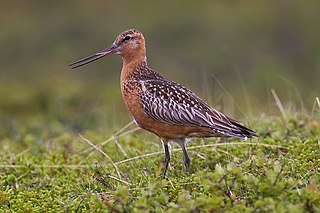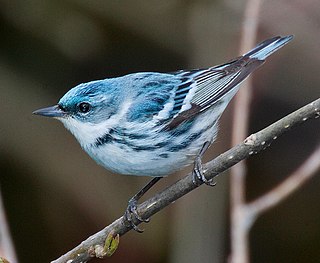
Bird migration is birds’ regular and annual seasonal journey between their breeding and wintering grounds. Birds that migrate usually travel along north and south flyways and often fly vast distances. Animal migration is inherently risky.

The Arctic warbler is a widespread leaf warbler in birch or mixed birch forest near water throughout its breeding range in Fennoscandia and the northern Palearctic. It has established a foothold in North America, breeding in Alaska. This warbler is strongly migratory; the entire population winters in southeast Asia. It therefore has one of the longest migrations of any Old World insectivorous bird.

Pallas's leaf warbler or Pallas's warbler, is a bird that breeds in mountain forests from southern Siberia east to northern Mongolia and northeast China. It is named for German zoologist Peter Simon Pallas, who first formally described it. This leaf warbler is strongly migratory, wintering mainly in south China and adjacent areas of southeast Asia, although in recent decades increasing numbers have been found in Europe in autumn.

The yellow-browed warbler is a leaf warbler which breeds in the east Palearctic. This warbler is strongly migratory and winters mainly in tropical South Asia and South-east Asia, but also in small numbers in western Europe. Like the rest of Phylloscopidae, it was formerly included in the Old World warbler assemblage.

Reverse migration, also called reverse misorientation, is a phenomenon whereby a bird migrates in the opposite direction to that typical of its species during the spring or autumn.

The bar-tailed godwit is a large and strongly migratory wader in the family Scolopacidae, which feeds on bristle-worms and shellfish on coastal mudflats and estuaries. It has distinctive red breeding plumage, long legs, and a long upturned bill. Bar-tailed godwits breed on Arctic coasts and tundra from Scandinavia to Alaska, and overwinter on coasts in temperate and tropical regions of Australia and New Zealand. The migration of the subspecies Limosa lapponica baueri across the Pacific Ocean from Alaska to New Zealand is the longest known non-stop flight of any bird, and also the longest journey without pausing to feed by any animal. The round-trip migration for this subspecies is over 29,000 km (18,020 mi).

Hume's leaf warbler or Hume's warbler is a small leaf warbler which breeds in the mountains of inner Asia. This warbler is migratory and winters mainly in India.

The garden warbler is a common and widespread small bird that breeds in most of Europe and in the Palearctic to western Siberia. It is a plain, long-winged and long-tailed typical warbler with brown upperparts and dull white underparts; the sexes are similar and juveniles resemble the adults. Its two subspecies differ only slightly and interbreed where their ranges overlap. Due to its lack of distinguishing features, this species can be confused with a number of other unstreaked warblers. The garden warbler's rich melodic song is similar to that of the blackcap, its closest relative, which competes with it for territory when nesting in the same woodland.

The sedge warbler is an Old World warbler in the genus Acrocephalus. It is a medium-sized warbler with a brown, streaked back and wings and a distinct pale supercilium. Sedge warblers are migratory, crossing the Sahara to get from their European and Asian breeding grounds to spend winter in Africa. The male's song is composed of random chattering phrases and can include mimicry of other species. The sedge warbler is mostly insectivorous.

The marsh warbler is an Old World warbler currently classified in the family Acrocephalidae. It breeds in temperate Europe and the western Palearctic and winters mainly in southeast Africa. It is notable for incorporating striking imitations of a wide variety of other birds into its song.

The pectoral sandpiper is a small, migratory wader that breeds in North America and Asia, wintering in South America and Oceania. It eats small invertebrates. Its nest, a hole scraped in the ground and with a thick lining, is deep enough to protect its four eggs from the cool breezes of its breeding grounds. The pectoral sandpiper is 21 cm (8.3 in) long, with a wingspan of 46 cm (18 in).

The yellow-rumped warbler is a regular North American bird species that can be commonly observed all across the continent. Its extensive distribution range connects both the Pacific and Atlantic coasts of the U.S. as well as Canada and Central America, with the population concentrating in the continent's northern parts during the breeding season and migrating southwards to southern North and Central America in Winter. The species generally prefers coniferous forests or mixed coniferous-deciduous forests as its breeding habitat, while during the winter it can be found inhabiting more open areas such as shrublands that offer food resources. The diet of the yellow-rumped warbler is based primarily on insects, though the species does eat fruits such as juniper berries as well, especially in winter.

The blackpoll warbler is a New World warbler. Breeding males are mostly black and white. They have a prominent black cap, white cheeks, and white wing bars. The blackpoll breeds in forests of northern North America, from Alaska throughout most of Canada, to the Adirondack Mountains of New York as well as New England in the Northeastern United States. They are a common migrant throughout much of North America. In fall, they fly south to the Greater Antilles and the northeastern coasts of South America in a non-stop long-distance migration over open water, averaging 2,500 km (1,600 mi), one of the longest-distance non-stop overwater flights ever recorded for a migratory songbird. Rare vagrants to western Europe, they are one of the more frequent transatlantic passerine wanderers.

The yellow warbler is a New World warbler species. Yellow warblers are the most widespread species in the diverse genus Setophaga, breeding in almost the whole of North America, the Caribbean, and down to northern South America.

The black-and-white warbler is a species of New World warbler, and the only member of its genus, Mniotilta. It breeds in northern and eastern North America and winters in Florida, Central America, and the West Indies down to Peru. This species is a very rare vagrant to western Europe.

The cerulean warbler is a small songbird in the family Parulidae. It is a long-distance migrant, breeding in eastern North American hardwood forests. In the non-breeding season, it winters on the eastern slope of the Andes in South America, preferring subtropical forests.

The Canada warbler is a small boreal songbird of the New World warbler family (Parulidae). It summers in Canada and northeastern United States and winters in northern South America.

The palm warbler is a small songbird of the New World warbler family.

Audubon's shearwater is a common tropical seabird in the petrel family. Sometimes known as the dusky-backed shearwater, the specific epithet honours the French naturalist Félix Louis L'Herminier.
Many species of North American landbird have been recorded in Great Britain as vagrants. Most occur in autumn; southwest England attracts the greatest proportion, but northern and western Scotland comes a close second. Occasionally birds overwinter, and some species are more prone to this than others. Vagrancy also occurs in spring, and some species do in fact have more records at this time than in autumn. Weather systems are thought to be the primary reason for the occurrence of birds in autumn; some birds seen in spring may simply be overshoots, although ship-assistance may also play a part.




















